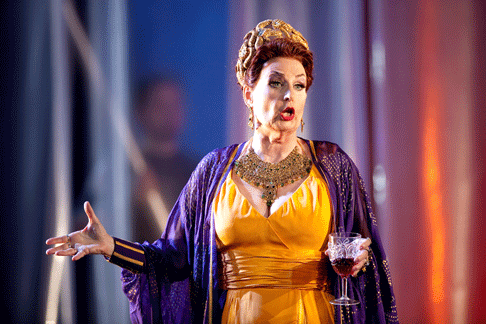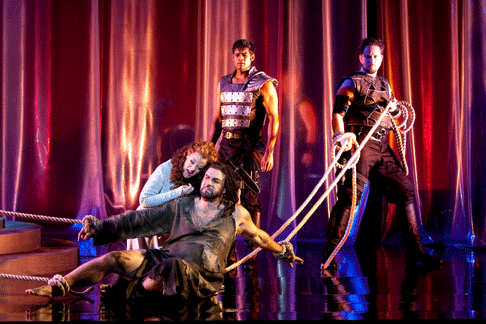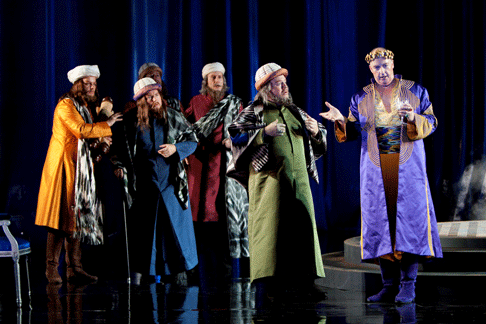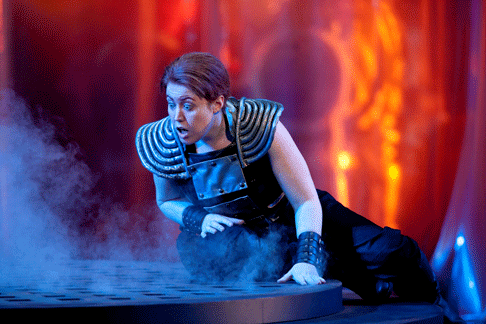![Salome (Voigt) revels in finally getting Jokanaan's head [Photo by Scott Suchman courtesy of Washington National Opera]](http://www.operatoday.com/Voigt_076_cr.-Scott-Suchman.gif)
13 Oct 2010
Salome at the Washington National Opera
With its playbill half-empty, its general director Placido Domingo resigning, and the talk of a takeover by the Kennedy Center, Washington National Opera is in a dire need of good news this season.
English Touring Opera are delighted to announce a season of lyric monodramas to tour nationally from October to December. The season features music for solo singer and piano by Argento, Britten, Tippett and Shostakovich with a bold and inventive approach to making opera during social distancing.
This tenth of ten Live from London concerts was in fact a recorded live performance from California. It was no less enjoyable for that, and it was also uplifting to learn that this wasn’t in fact the ‘last’ LfL event that we will be able to enjoy, courtesy of VOCES8 and their fellow vocal ensembles (more below …).
Ever since Wigmore Hall announced their superb series of autumn concerts, all streamed live and available free of charge, I’d been looking forward to this song recital by Ian Bostridge and Imogen Cooper.
Although Stile Antico’s programme article for their Live from London recital introduced their selection from the many treasures of the English Renaissance in the context of the theological debates and upheavals of the Tudor and Elizabethan years, their performance was more evocative of private chamber music than of public liturgy.
Evidently, face masks don’t stifle appreciative “Bravo!”s. And, reducing audience numbers doesn’t lower the volume of such acclamations. For, the audience at Wigmore Hall gave soprano Elizabeth Llewellyn and pianist Simon Lepper a greatly deserved warm reception and hearty response following this lunchtime recital of late-Romantic song.
For this week’s Live from London vocal recital we moved from the home of VOCES8, St Anne and St Agnes in the City of London, to Kings Place, where The Sixteen - who have been associate artists at the venue for some time - presented a programme of music and words bound together by the theme of ‘reflection’.
'Such is your divine Disposation that both you excellently understand, and royally entertaine the Exercise of Musicke.’
‘And there was war in heaven: Michael and his angels fought against the dragon; and the dragon fought and his angels, And prevailed not; neither was their place found any more in heaven … that old serpent … Satan, which deceiveth the whole world: he was cast out into the earth, and his angels were cast out with him.’
There was never any doubt that the fifth of the twelve Met Stars Live in Concert broadcasts was going to be a palpably intense and vivid event, as well as a musically stunning and theatrically enervating experience.
‘Love’ was the theme for this Live from London performance by Apollo5. Given the complexity and diversity of that human emotion, and Apollo5’s reputation for versatility and diverse repertoire, ranging from Renaissance choral music to jazz, from contemporary classical works to popular song, it was no surprise that their programme spanned 500 years and several musical styles.
The Academy of St Martin in the Fields have titled their autumn series of eight concerts - which are taking place at 5pm and 7.30pm on two Saturdays each month at their home venue in Trafalgar Square, and being filmed for streaming the following Thursday - ‘re:connect’.
The London Symphony Orchestra opened their Autumn 2020 season with a homage to Oliver Knussen, who died at the age of 66 in July 2018. The programme traced a national musical lineage through the twentieth century, from Britten to Knussen, on to Mark-Anthony Turnage, and entwining the LSO and Rattle too.
With the Live from London digital vocal festival entering the second half of the series, the festival’s host, VOCES8, returned to their home at St Annes and St Agnes in the City of London to present a sequence of ‘Choral Dances’ - vocal music inspired by dance, embracing diverse genres from the Renaissance madrigal to swing jazz.
Just a few unison string wriggles from the opening of Mozart’s overture to Le nozze di Figaro are enough to make any opera-lover perch on the edge of their seat, in excited anticipation of the drama in music to come, so there could be no other curtain-raiser for this Gala Concert at the Royal Opera House, the latest instalment from ‘their House’ to ‘our houses’.
"Before the ending of the day, creator of all things, we pray that, with your accustomed mercy, you may watch over us."
The doors at The Metropolitan Opera will not open to live audiences until 2021 at the earliest, and the likelihood of normal operatic life resuming in cities around the world looks but a distant dream at present. But, while we may not be invited from our homes into the opera house for some time yet, with its free daily screenings of past productions and its pay-per-view Met Stars Live in Concert series, the Met continues to bring opera into our homes.
Music-making at this year’s Grange Festival Opera may have fallen silent in June and July, but the country house and extensive grounds of The Grange provided an ideal setting for a weekend of twelve specially conceived ‘promenade’ performances encompassing music and dance.
There’s a “slide of harmony” and “all the bones leave your body at that moment and you collapse to the floor, it’s so extraordinary.”
“Music for a while, shall all your cares beguile.”
The hum of bees rising from myriad scented blooms; gentle strains of birdsong; the cheerful chatter of picnickers beside a still lake; decorous thwacks of leather on willow; song and music floating through the warm evening air.
![Salome (Voigt) revels in finally getting Jokanaan's head [Photo by Scott Suchman courtesy of Washington National Opera]](http://www.operatoday.com/Voigt_076_cr.-Scott-Suchman.gif)
With its playbill half-empty, its general director Placido Domingo resigning, and the talk of a takeover by the Kennedy Center, Washington National Opera is in a dire need of good news this season.
The horizon looks brighter these days, thanks to a brand-new production of Richard Strauss’ decadent blockbuster, Salome (1905), based on Oscar Wilde’s infamous play. Staged by a sought-after drama and opera director Francesca Zambello, this production is an impressive experience. The central element of the set is a floor-to-ceiling, transparent plastic curtain that separates the dark courtyard of the proscenium, with the cistern at its center, from the illuminated banquet table at the back of the stage. In her comments about the production, Zambello discusses her vision of Herod’s court being trapped in an endless cheery feast, as imprisoned in its public role as Jokanaan is in his cistern, and much less free. The plastic indeed gives an impression both of artificiality and of being enclosed, wrapped up, vacuum-sealed. Additionally, it provides a grateful surface for the lighting designer Mark McCullough, whose vivid colors flooding the stage in gold, blue, purple, and blood-red glow is one of the most important aspects of the production.
The main attraction of the evening was acclaimed American dramatic soprano Deborah Voigt as Salome. Throughout the performance, Voigt had no trouble defending her reputation as one of today’s definitive interpreters of this fiendishly complex role. I say this despite the fact that the singer’s low register is much less powerful than her high, so some phrases, especially in the chatty opening scenes, tended to get lost in the orchestral fabric, for no live performer of this role can expect to carry its every note equally; the only perfect Salome is a recorded one. What is perhaps most fascinating about a staged production of this opera is watching the lead singer read the title role. Which of the numerous possible variations of Salome’s character, her relationship to her family, and the motivations for her obsession are we going to see? Is this Salome to be condemned or redeemed; is she a victor or a victim?
Voigt’s interpretation seems to follow what one might call a Teresa Stratas model. She plays Salome “young”; vulnerable and strangely innocent, she is like a spoilt, mischievous child longing for a toy, trying to articulate her desires more to herself than to their object. The director’s reading of the story suggests that although Salome is habitually molested not only by her stepfather, but also the soldiers of the palace guard, she is not mature enough to process the experience. She flirts with anyone who has the power of getting her what she wants, but seems not to comprehend her counterparts’ reactions to her presence. In her unguarded moments, she responds with an almost violent repulsion to any male’s physical proximity to her, however innocent. Thus, we begin to understand her immediate fascination with the hidden Jokanaan: she is attracted to his “absence”; to the unreality of his disembodied voice carried powerfully out of the cistern.
Salome is a dark opera; literally dark, as the libretto specifies a nighttime setting, and psychologically dark, the story tailor-made for a twisted Freudian reading. What struck me as unusual and unexpected in Voigt’s interpretation are the moments when she radiates a palpable sense of joy, quiet shimmering contentment. The singer starts her final “Apostrophe to the Head” softly, almost whispering.
 Doris Soffel as Herodias
Doris Soffel as Herodias
She takes her time closing in on Jokanaan’s severed head, savoring the experience of the first kiss (perhaps – or so Voigt would have us believe – it really is her first one). This scene, often a place of unrestrained hysteria, is understated, at times almost demure. Salome’s clothing incorporates a gown of deep red (similar to Maria Ewing’s costume from the Covent Garden production) over a white dress resembling the one Catherine Malfitano wears in the Met staging. Yet, by the end of the scene, Voigt’s Salome is not bathed in blood like Malfitano’s. Rather, only the tips of her fingers are bloody, like a shiny manicure; she then touches her fingers to her cheeks, as if applying rouge to match her pretty dress. This Salome does not embrace the horror of the experience; her world is entirely outside it.
The only disappointing moment of the role was its most anticipated one – the Dance of the Seven Veils. It seems that Zambello and the choreographer, Yael Levitin Saban (or perhaps Voigt herself, depending on who made the ultimate decision about how to stage the scene) could not make up their minds about how risqué they wanted the dance to get. So, the veils came off, but were immediately replaced by other veils (provided by four dancing assistants – all, alas, much younger, thinner, and more flexible than the star attraction). Voigt performed the dance herself rather than being replaced by a double, but her efforts seemed half-hearted, with barely a movement of the hips and much awkward arm waving. Finally, on the ultimate question: “to strip or not to strip” (the question that every Salome watcher wants answered!), the decision was apparently to do both (or neither?): at the end of the dance, Voigt appeared in a thick, unfortunate-looking bodysuit for about a chord and a half, before being covered with the veils again. Overall, it looked like Herod made a bad bargain: this dance was not worth a hair off the prophet’s head.
 Narraboth (Panikkar) and the Second Soldier (Rhodovi) look on anxiously as Salome (Voigt) tries to entice Jokanaan (Sumegi)
Narraboth (Panikkar) and the Second Soldier (Rhodovi) look on anxiously as Salome (Voigt) tries to entice Jokanaan (Sumegi)
Particularly this prophet, for Australian bass-baritone Daniel Sumegi stole the show as Jokanaan. His deep, thunderous voice and his carpenter physique accentuated by clever body make-up made Salome’s lack of self-control feel entirely plausible. Strauss does not give a Jokanaan performer much to work with: his lines are squarely diatonic, monotonous, and dull. Yet Sumegi (under Zambello’s inspired direction) brought an unexpected complexity to the role by placing Jokanaan into an unusual physical proximity to Salome and thus forcing him to respond, perhaps against his will, to her vital, lustrous sensuality. This Jokanaan is forced to feel for Salome the same passion exhibited by every male character on stage, from Herod to a common soldier. We see him visibly tearing his hands away from her each time he forces himself to reject her. The moment toward the end of the duet when Salome melts into his arms as he is rocking her back and forth, like a child, their bodies bathed in a golden light and their faces lifted upward in ecstasy (both spiritual and sensual) at their impossible union is a masterstroke. Although one does wish that particular golden color were used more sparingly, or perhaps even saved for that climactic moment. As it is, the gold shimmer that accompanies just about every sound uttered from the cistern in the opening scene might be a bit of overkill. It is as if Zambello was trying to counteract the composer’s atheism and his evident dislike of Jokanaan’s character by validating the imprisoned prophet’s every word. It almost makes one sympathize with poor Herodias, who does not believe in miracles and wishes that the annoying man would just be quiet.
 Herod (Berkeley-Steele) explains to the Jews (Weber, Bailey, Rotz, Augustin and Morris) how he thinks Jokanann is a holy man.
Herod (Berkeley-Steele) explains to the Jews (Weber, Bailey, Rotz, Augustin and Morris) how he thinks Jokanann is a holy man.
Speaking of the Queen of Judea, German mezzo-soprano Dorris Soffel, in her WNO debut, was a fabulously unpleasant Herodias – cold, ambitious, greedy, jealous, and proud. Her powerful voice carried easily over the orchestra and over her husband’s shy tenor. She also held her own well in a power struggle with Voigt’s Salome; when Herod says despairingly: “she is her mother’s daughter,” he only confirms what the audience has already perceived. British tenor Richard Berkeley-Steele was undoubtedly the weakest of the soloists, yet he proved an effective Herod – a feeble personality entirely dominated by his women and unable to decide whether he was more terrified of God’s prophet or his own wife. Equally effective in his role was young American tenor Sean Panikkar (Narraboth), whose clear tenor carries both the metal of a soldier and vulnerability of an infatuated youth. Panikkar, who has also made his WNO debut in this production, is a wonderful find; hopefully, we will hear him in Washington again. Cynthia Hanna, on the other hand, was a disappointing Page.
Zambello’s new staging and much of the vocal cast was not all that was new in WNO’s Salome: the orchestra was led by its newly appointed music director, Philippe Auguin, whose selection was announced mere two days before the premiere. Auguin is familiar to the Washington audiences from his acclaimed concert performances of Götterdämmerung last November, and the ensemble appears to have welcomed his presence at the podium. It has palpably reawakened under Auguin’s deft leadership, and acquitted itself creditably in the extremely complex Strauss score. There were still issues of balance: at one point, the timpani were so outrageously loud that they made Voigt’s already difficult job of out-singing a late Romantic orchestra well-nigh impossible. But at least, the musicians were in tune, and the embarrassing lapses in the winds and brass that I often remarked upon in my previous WNO reviews have been mostly avoided. While some moments worked better than others, their performance allowed the audience to be swept away by the feverish intensity of the score, matched almost without exception by the director’s vision.
 Page of Herodias (Hanna) peers into the cistern.
Page of Herodias (Hanna) peers into the cistern.
The main difficulty in staging Salome, in my opinion, lies in the fact that Richard Strauss conceived it as a true music drama. The production only works if all its elements – the rendition of the score by singers and orchestra, the sets, the costumes, the lighting, the acting and the stage movement – are of equally and consistently high quality. Even by this admittedly impossible standard, I would call WNO’s new Salome a success. Let us hope that the company’s spring line-up of Madama Butterfly, Iphigénie in Tauride, and Don Pasquale proves as memorable.
Olga Haldey